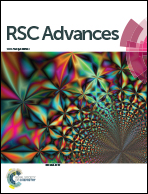Synthesis of WO3·H2O nanoparticles by pulsed plasma in liquid
Abstract
Pure orthorhombic-phase WO3·H2O nanoparticles with sizes of about 5 nm were synthesized by pulsed plasma in deionized water, in which tungsten electrodes provide the source of tungsten and the water is the source of oxygen and hydrogen. The quenching effect and liquid environment inherent in this pulsed plasma in liquid method resulted in ultra-small particles with lattice lengths (a = 5.2516 Å, b = 10.4345 Å, c = 5.1380 Å) larger than those of reference lattices. The emission lines of W I atoms, W II ions and H I atoms were observed by an optical emission spectrum in order to gather information on the synthetic mechanism. These nanoparticles showed higher absorption in the visible region than did ST-01 TiO2 and Wako WO3 nanoparticles. The WO3·H2O nanoparticles displayed more activity in the photocatalytic test than did the commercial TiO2 sample (ST-01). Also, the absorption edge of WO3·H2O shifted to longer wavelengths in the UV-Vis absorption pattern relative to that of the anhydrous tungsten oxide.


 Please wait while we load your content...
Please wait while we load your content...